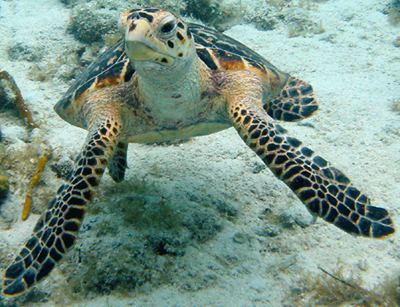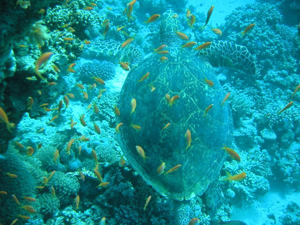Hawksbill Turtle

Common Name: Hawksbill Turtle
Scientific Name: Eretmochelys imbricata
Description
The hawksbill turtle is small to medium-sized compared to other sea turtle species. Adults weigh 100-150 lbs (45 to 68 kg) on average, but can grow as large as 200 lbs (91 kg). Hatchlings weigh about 0.5 oz (14 g).
The carapace (top shell) of an adult ranges from 25 to 35 inches (63 to 90 cm) in length and has a "tortoiseshell" coloring, ranging from dark to golden brown, with streaks of orange, red, and/or black. The shells of hatchlings are 1-2 inches (about 42 mm) long and are mostly brown and somewhat heart-shaped. The plastron (bottom shell) is clear yellow. The rear edge of the carapace is almost always serrated, except in older adults, and has overlapping "scutes".
The hawksbill turtle's head is elongated and tapers to a point, with a beak-like mouth that gives the species its name. The shape of the mouth allows the hawksbill turtle to reach into holes and crevices of coral reefs to find sponges, their primary food source as adults, and other invertebrates. Hawksbill turtles are unique among sea turtles in that they have two pairs of prefrontal scales on the top of the head and each of the flippers usually has two claws.

Male hawksbills mature when they are about 27 inches (69 cm) long. Females mature at about 31 inches (78 cm). The ages at which turtles reach these lengths are unknown.
Female hawksbills return to their natal beaches every 2-3 years to nest at night approximately every 14-16 days during the nesting season. A female hawksbill generally lays 3-5 nests per season, which contain an average of 130 eggs. Hawksbill turtles usually nest high up on the beach under or in the beach/dune vegetation on both calm and turbulent beaches. They commonly nest on pocket beaches, with little or no sand.
Breeding areas and nesting seasons
Along the Great Barrier Reef, hawksbills nest in low numbers from just north of Princess Charlotte Bay to Torres Strait. Nesting also occurs in the Northern Territory and Western Australia.
Two major breeding areas occur in Australia:
Northern Great Barrier Reef, Torres Strait and northeastern Arnhem Land have several significant rookeries including: Milman, Johnson, Bouydong, Bird and Piper Islands in the northern GBR; Aukane, Kabikane, Mimi, Bet, Sassie and Lacey Islands in Torres Strait; and Hawk, North East and Truant Islands in north east Arnem Lan.
The north west shelf has several significant rookeries including Rosemary and Varanus Islands.
Although hawksbills breed throughout the year, the peak nesting period in the Torres Strait and Great Barrier Reef region occurs between January and April. In Arnhem Land, nesting peaks between July and September.
Diet
Sponges make up a major part of the diet of hawksbills, although they also feed on seagrasses, algae, soft corals and shellfish.
The hawksbill turtle has a distinctive parrot-like beak.
Hawksbill turtle carapace:
- 4 pairs or more of large scales on either side (coastal scales)
- Thick overlapping carapace scales
- Carapace low domed with upturned edges
- Colour olive grey
- Adult carapace approx. 0.8m
Population and Distribution
Hawksbills are solitary nesters and, thus, determining population trends or estimates on nesting beaches is difficult. The largest populations of hawksbills are found in the Caribbean, the Republic of Seychelles, Indonesia, and Australia.
The most significant nesting within the U.S. occurs in Puerto Rico and the U.S. Virgin Islands, specifically on Mona Island and Buck Island, respectively. Each year, about 500-1000 hawksbill nests are laid on Mona Island, Puerto Rico (Diez and van Dam 2006) and another 100-150 nests on Buck Island Reef National Monument off St. Croix in the U.S. Virgin Islands (Z. Hillis-Starr. pers. comm.). Nesting also occurs on other beaches in St. Croix and on St. John, St. Thomas, Culebra Island, Vieques Island, and mainland Puerto Rico. Within the continental U.S., nesting is restricted to the southeast coast of Florida and the Florida Keys, but nesting is rare in these areas. No nesting occurs on the west coast of the U.S. mainland. In the U.S. Pacific, hawksbills nest only on main island beaches in Hawaii, primarily along the east coast of the island of Hawaii. Hawksbill nesting has also been documented in American Samoa and Guam.
In addition to nesting beaches in the U.S. Caribbean, hawksbills nest at numerous other sites throughout the Caribbean, with the majority of nesting occurring in Mexico and Cuba. In Mexico, about 2,800 hawksbills nest in Campeche, Yucatán, and Quintana Roo each year (Spotila 2004). Lutz et al. estimate the number of adult hawksbills living in the Caribbean today is 27,000 (2003).
The largest nesting population of hawksbills appears to occur in Australia. Approximately 2,000 hawksbills nest on the northwest coast of Australia and about 6,000 to 8,000 off the Great Barrier Reef each year (Spotila 2004). Additionally, about 2,000 hawksbills nest each year in Indonesia and 1,000 in the Republic of Seychelles (Spotila 2004).
Threats
Hawksbills face threats on both nesting beaches and in the marine environment. The primary global threat to hawksbills is habitat loss of coral reef communities. Coral reefs are vulnerable to destruction and degradation caused by human activities. Humans can alter coral reefs either gradually (i.e., pollution can degrade habitat quality) or catastrophically (e.g., toxic spills and vessel groundings). Recent evidence suggests that global climate change is negatively impacting coral reefs by causing higher incidences of coral diseases, which can ultimately kill entire coral reef communities. Hawksbill turtles rely on coral reefs for food resources and habitat. As these communities continue to decline in quantity and quality, hawksbills will have reduced foraging opportunities and limited habitat options.
Historically, commercial exploitation was the primary cause of the decline of hawksbill sea turtles. There remains a continuing demand for the hawksbill's shell as well as other products, including leather, oil, perfume, and cosmetics. The British Virgin Islands, Cayman Islands, Cuba, Haiti, and the Turks and Caicos Islands (U.K.) all permit some form of legal take of hawksbill turtles. In the northern Caribbean, hawksbills are directly harvested primarily for their carapace, which is often carved into hair clips, combs, jewelry, and other trinkets. Additionally, hawksbills are harvested for their eggs and meat while whole stuffed turtles are sold as curios in the tourist trade. Hawksbill products are openly available in the Dominican Republic and Jamaica despite a prohibition on harvesting hawksbills and eggs (Fleming 2001).
In the Pacific, directed harvest of nesting females and eggs on the beach and hawksbills in the water is still widespread. Directed take is a major threat to hawksbills in American Samoa, Guam, the Republic of Palau, the Commonwealth of the Northern Mariana Islands, the Federated States of Micronesia, and the Republic of the Marshall Islands (NMFS and USFWS 1998). In addition to directed harvest, increased human presence is a threat to hawksbills throughout the Pacific. In particular, increased recreational and commercial use of nesting beaches, beach camping and fires, litter and other refuse, general harassment of turtles, and loss of nesting habitat from human activities negatively impact hawksbills.
 Deep Sea Crabs
Deep Sea Crabs